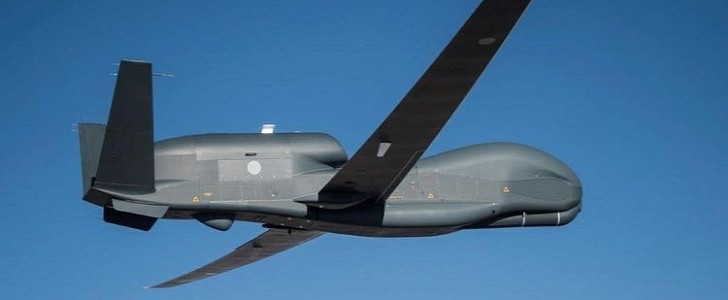As if the active wildfires across the U.S. weren’t bad enough, a different kind of fire broke out on August 6, as a result of a military aircraft crash. Thankfully, unlike the recent sightseeing plane crash in Alaska, there were no victims, since this was an unmanned aircraft system (UAS), the RQ-4 Global Hawk military drone.
It seemed like a regular day at the Grand Forks Air Force Base, home to the 319th Reconnaissance Wing, which operates the Global Hawk. That was about to change around 7:00 a.m. Central Standard Time, when an RQ-4 that was returning to base suffered a crash, for reasons that are yet unknown. According to the official statement released by the Grand Forks Air Force Base, the incident took place a rural field near Gilby, in North Dakota.
Luckily, the fire that broke out was extinguished and nobody got hurt at the scene of the accident. Although no official images have been released so far, it’s not hard to imagine the damage that a 14,950-pound (6,782 kg) aircraft with a 130.9-foot (40 meters) wingspan can cause. It really was lucky that there was no one in the area that could have gotten hurt.
It’s almost ironic that this giant “spy drone” that is specifically meant to perform stealthy ISR (Intelligence, Surveillance, Reconnaissance) tasks, failed in such a striking manner. It’s been in service with the U.S. Air Force for decades, but the particular one that crashed was a Block 40 model, which means it was the latest version. The Block 40 Global Hawks were the first to integrate the Radar Technology Insertion Program (RTIP) for Ground Moving Target Indicator (GMTI) data.
Able to reach a 310 knots (357 mph) speed, the RQ-4 Global Hawk UAS was meant to be able to sustain flights over 30 hours at high altitudes, in any type of weather, day or night, while collecting near-real-time critical data. And it wasn’t cheap either – which makes the loss even more substantial for USAF.
Since yesterday, the public was requested to stay away from the area until the investigation is completed. Col. Jeremy Fields, 319th Reconnaissance Wing vice commander, said that the military investigation will likely take several weeks. Hopefully, there will be a reasonable explanation for what brought down the RQ-4 drone, on a seemingly routine flight.
Luckily, the fire that broke out was extinguished and nobody got hurt at the scene of the accident. Although no official images have been released so far, it’s not hard to imagine the damage that a 14,950-pound (6,782 kg) aircraft with a 130.9-foot (40 meters) wingspan can cause. It really was lucky that there was no one in the area that could have gotten hurt.
It’s almost ironic that this giant “spy drone” that is specifically meant to perform stealthy ISR (Intelligence, Surveillance, Reconnaissance) tasks, failed in such a striking manner. It’s been in service with the U.S. Air Force for decades, but the particular one that crashed was a Block 40 model, which means it was the latest version. The Block 40 Global Hawks were the first to integrate the Radar Technology Insertion Program (RTIP) for Ground Moving Target Indicator (GMTI) data.
Able to reach a 310 knots (357 mph) speed, the RQ-4 Global Hawk UAS was meant to be able to sustain flights over 30 hours at high altitudes, in any type of weather, day or night, while collecting near-real-time critical data. And it wasn’t cheap either – which makes the loss even more substantial for USAF.
Since yesterday, the public was requested to stay away from the area until the investigation is completed. Col. Jeremy Fields, 319th Reconnaissance Wing vice commander, said that the military investigation will likely take several weeks. Hopefully, there will be a reasonable explanation for what brought down the RQ-4 drone, on a seemingly routine flight.







